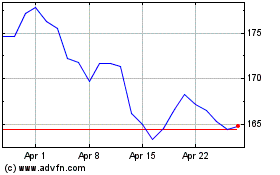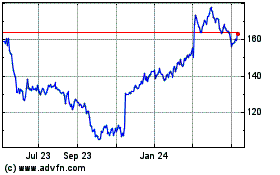Target Freshens Up Staff For Its Grocery Business -- WSJ
September 08 2016 - 3:03AM
Dow Jones News
By Khadeeja Safdar
Target Corp. is building dedicated teams to manage the grocery
sections of its stores as part of an effort to turn around
declining sales in its food business.
Grocery employees will no longer work in other parts of the
store and they will receive specialized training, including
handling backroom inventory and interacting with customers. Each
grocery team will have 10 to 60 employees, depending on the
store.
The changes have already been rolled out to about 450 stores and
are expected to appear in another 150 by next month. The new
approach is part of an effort "to improve our offering, better
cater to our guests and drive growth," said Katie Boylan, a Target
spokeswoman.
The company declined to discuss the cost of the program or how
the changes might affect worker wages.
The stakes are high for Target to improve groceries, which
account for about a fifth of its revenue. Fewer shoppers visiting
stores to buy its perishable foods has been a drag on profits at a
time when the retailer is facing declining sales.
Since taking over in 2014, CEO Brian Cornell has tried to make
Target a more compelling destination for groceries. The former
Safeway Inc. and PepsiCo Inc. executive has changed leadership in
the category, added more organic items to the assortment and
invested in store design.
Under the new workforce changes, Target has created a regional
leadership position called grocery director to supervise strategy.
Each grocery director oversees food-related decisions at about 60
stores and reports to Target's store operations team at its
headquarters in Minneapolis.
The company has so far hired 10 people with expertise in
groceries for the salaried position and is planning to add
one-to-two per key market. This person will "provide education and
oversight that helps store teams make more informed decisions," Ms.
Boylan said.
Analysts say the new setup is a step in the right direction but
won't be enough to transform the retailer into a food destination.
Having a specialized workforce and leadership closer to the store
level "will probably help improve their groceries, but it doesn't
change the fact that there is friction for the shopper on what it
means to go on a Target shopping trip," said Kantar Retail analyst
Amy Koo.
The changes in the grocery operating model are spearheaded by
Target executive Aaron Alt, who was brought in earlier this year
with the title senior vice president of grocery transformation. Mr.
Alt is working to streamline the backroom area in stores and
allocate more resources to the front, according to a person
familiar with the matter.
Despite efforts to improve performance, grocery sales declined
during the second quarter. The company also cut its annual profit
target last month and warned same-store sales would be flat to down
2% for the fiscal year.
In addition to the labor changes, the company has also said it
plans to increase grocery promotions and marketing efforts.
Write to Khadeeja Safdar at khadeeja.safdar@wsj.com
(END) Dow Jones Newswires
September 08, 2016 02:48 ET (06:48 GMT)
Copyright (c) 2016 Dow Jones & Company, Inc.
Target (NYSE:TGT)
Historical Stock Chart
From Mar 2024 to Apr 2024

Target (NYSE:TGT)
Historical Stock Chart
From Apr 2023 to Apr 2024
